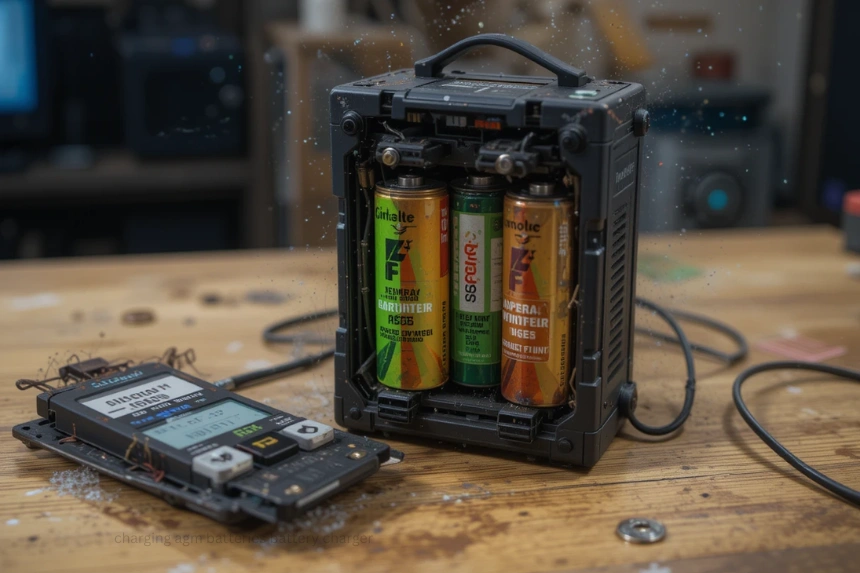Charging AGM batteries properly is essential for maintaining their performance, longevity, and safety. As one of the most popular types of deep-cycle and starting batteries used in automotive, marine, and industrial applications, AGM batteries require specific care when it comes to recharging. The right battery charger and proper charging procedures ensure your AGM batteries remain reliable and efficient for years to come. This comprehensive guide dives into everything you need to know about Charging AGM Batteries Battery Charger, including choosing the right charger, best practices, and safety tips.
Understanding AGM Batteries and the Importance of Proper Charging
AGM (Absorbent Glass Mat) batteries are sealed, maintenance-free lead-acid batteries that use fiberglass mats to hold electrolyte, making them spill-proof and highly resistant to vibrations. These features make AGM batteries ideal for vehicles, boats, and backup power systems. However, their sealed design and special chemistry necessitate careful charging to prevent damage, overcharging, or undercharging that could reduce lifespan and performance.
Knowing the special features of AGM batteries is essential to charging them properly with a battery charger.Unlike traditional flooded batteries, AGM batteries require a specific charging profile to achieve optimal results without damaging the plates or causing capacity loss.
Choosing the Right Battery Charger for AGM Batteries
Not every charger is suitable for AGM batteries. Using an incompatible charger can lead to overcharging, overheating, or reduced battery life. Here’s what to look for:
1. Smart or Digital Chargers
Opt for a smart charger equipped with microprocessors that can automatically detect the battery’s state of charge and adjust the voltage and current accordingly. These chargers usually feature multiple charging modes optimized for AGM, Gel, and other lead-acid batteries.
2. Selectable Charge Modes
Select an AGM battery charger with particular settings.The charger should offer a gentle, regulated charging profile with a bulk, absorption, and float stage tailored to AGM chemistry.
3. Voltage and Current Ratings
Voltage: During the absorption period, AGM batteries normally need a charging voltage of 14.4V to 14.8V.
Current: The charging current should be appropriate to the battery’s capacity; a rate of 10-20% of the battery capacity is generally recommended.
4. Safety Features
Look for built-in safety features such as spark-proof design, reverse polarity protection, and temperature compensation, especially for outdoor or in-vehicle charging.
5. Connectivity and Indicators
A good charger should have clear LED indicators or a digital display showing charging status, voltage, and current. Some advanced models also include remote monitoring features.
Best Practices for Charging AGM Batteries Battery Charger
Proper charging not only extends your AGM battery’s lifespan but also ensures safety during the process. Here are essential steps and tips:
1. Inspect the Battery
Before charging, check the battery for any physical damage, leaks, or corrosion around the terminals. Clean terminals if necessary to ensure good electrical contact.
2. Select the Appropriate Charger Setting
Set your charger to AGM mode if available. For instance, adjust the current based on the battery’s capacity and set the voltage between 14.4 and 14.8 volts.
3. Connect the Charger Correctly
- Connect the charger cables to the proper terminals—positive (red) to positive, negative (black) to negative.
- To avoid reverse polarity damage, double-check the charger’s polarity before turning it on.
4. Start the Charging Process
Turn on the charger and allow it to operate through the various stages:
Bulk Charging: Rapidly delivers current to replenish the battery.
Absorption Phase: Voltage holds steady while current decreases as the battery reaches full charge.
Float Mode: Maintains the full charge without overcharging.
5. Monitoring the Charge
Pay attention to the display of voltage and current.A properly functioning charger will automatically reduce current as the battery approaches full capacity. Never leave the battery unattended for extended periods during charging, especially if your charger lacks automatic shutoff.
6. Completion and Disconnection
Once the charger indicates full charge or the current drops to a minimal level, turn off the charger and carefully disconnect the cables. If using a charger with a float mode, allow the battery to rest for a few hours before use for a stable voltage.
7. Post-Charge Maintenance
Inspect the battery terminals again, clean if needed, and ensure the battery is stored in a cool, dry place if not immediately installed.
Safety Tips When Charging AGM Batteries
Avoid Overcharging: Excessive voltage can damage AGM plates, reduce capacity, and cause overheating or venting.
Keep Batteries Cool: Excess heat during charging can degrade battery life.
Ventilation: Charge in a well-ventilated area to disperse any potential gases.
Use Proper PPE: Wear gloves and eye protection as batteries can emit corrosive gases or emit acid if damaged.
Check for Damage: Do not charge damaged or swollen batteries to prevent accidents.
Troubleshooting Common Charging Issues
Battery Not Charging: Confirm proper connection, charger settings, and that the charger is functioning.
Overheating: Reduce charging current or voltage, and check for damaged batteries.
Incomplete Charging: Ensure the charger’s settings match AGM specifications and that the battery is not faulty.
Conclusion
Charging AGM Batteries Battery Charger is a straightforward process when using the right equipment and following best practices. With a smart charger designed for AGM chemistry, correct connection, and vigilant monitoring, you can maximize your battery’s performance and lifespan. Proper charging not only guarantees reliable vehicle operation but also enhances safety and reduces replacement costs.
By understanding the nuances of AGM battery charging, vehicle owners, boating enthusiasts, and professionals can keep their batteries in top condition, ensuring seamless power delivery for years ahead.



